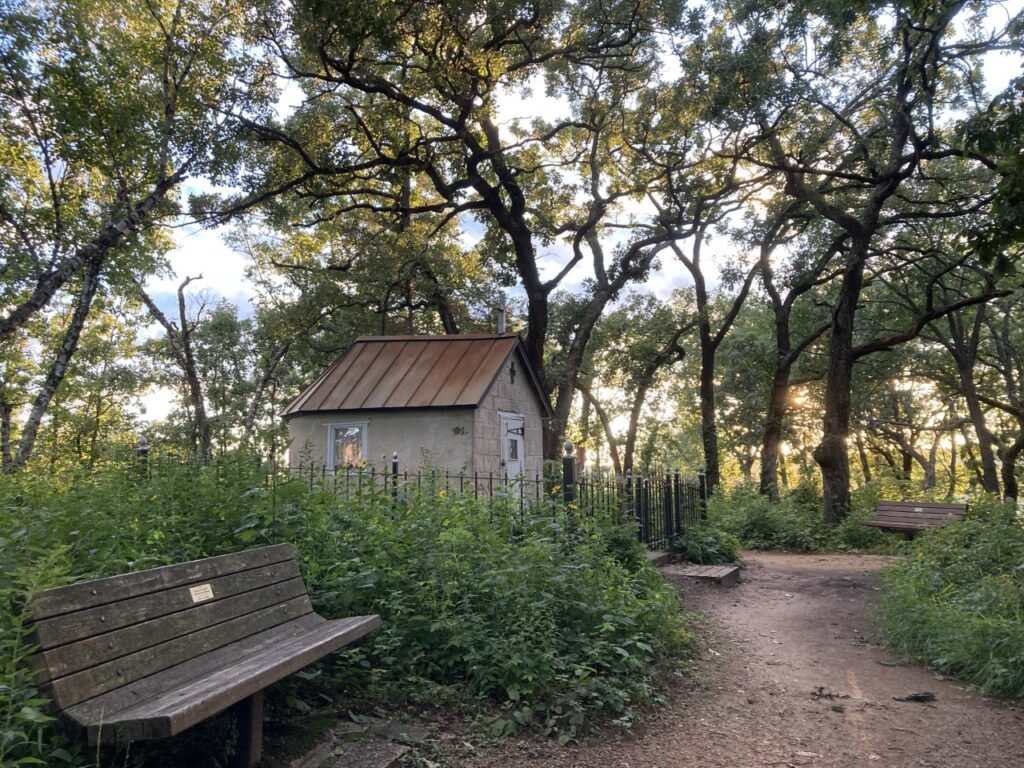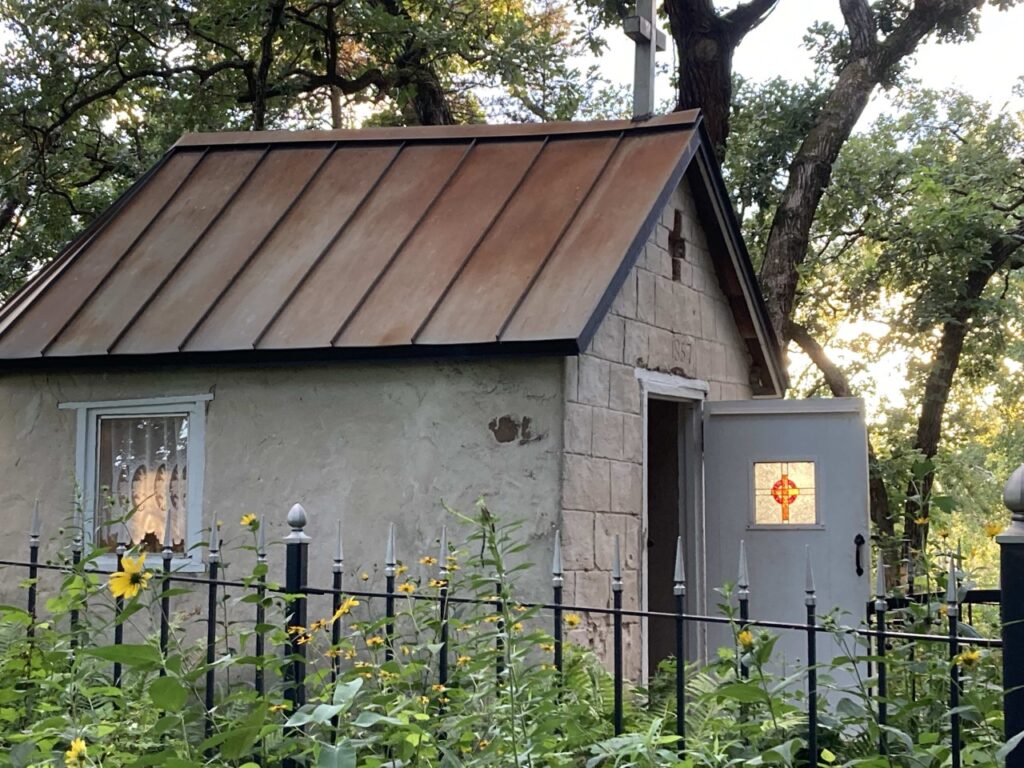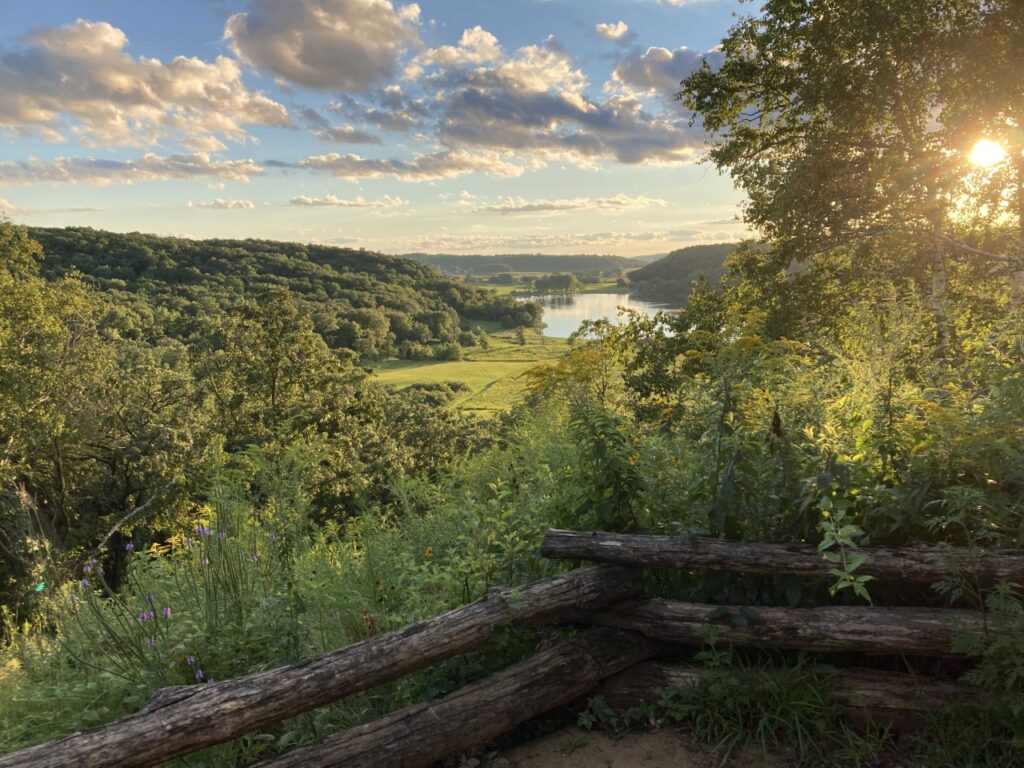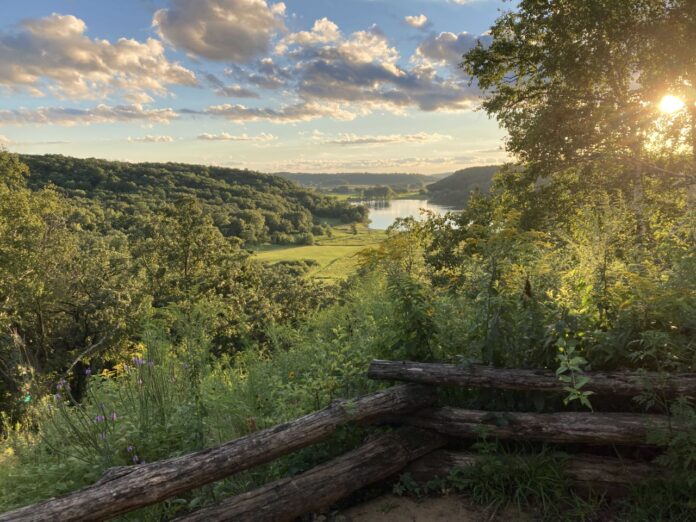By Ryan Hellenbrand
Gnarly oaks who have clearly borne the passage of time with dignity stand atop a hill overlooking Indian Lake off Wisconsin State Highway 19. Their tall stature and curling limbs seem to embrace the unassuming chapel that resides here. The small structure peeks through the space left by fallen leaves, almost blending into the backdrop of the successional growth developing around it. This little landmark, tucked away in the countryside outside of Madison, is the nexus of my complex entanglement in the stories of this place. For some, Wisconsin is practically synonymous with German-America, while simultaneously being connected to expansive forests across the Upper Midwest. The confluence of German migration with the implementation of forestry is crucial to telling a critical (hi)story of forestry in Wisconsin. German foresters in the U.S. and Americans who went to Germany to become foresters mobilized myths about German cultural connections to justify forestry across this area.

Forests symbolized the vitality of a nation, and forestry was seen as a reflection of the purportedly intimate relationship between a people and their territory. The implementation of forestry in Wisconsin is part of an ongoing history that eclipses longstanding and continued relationships Native Nations have with these same landscapes. As a graduate student in Environment and Resources, and a forestry/restoration practitioner, I seek to answer the question: how can I ethically engage this work to help create decolonial futures that support and strengthen Native sovereignty? To do this, I start by following Kanngieser and Todd’s (2020) push to move from environmental case studies to kin studies.1 The methodological shift that they propose foregrounds questions of how one is situated in and moves through a place. This resonates with Mathews’ idea of “throughscapes” – the entangled layers of multiple histories that converge on a landscape.2 Bringing these ideas together informs my encounter with the chapel at Indian Lake.
Kanngieser and Todd (Métis) offer environmental kin study as a radical alternative to the conventional case study in Environmental History. By applying methods of listening and attuning, this methodology offers scholars an opportunity to attend to the damages of dominant historical narratives that continue to elide ethical responsibilities to communities and Land.3 The conventional case study approach alienates knowledge from its place; the case study “is designed to travel—to be applied in future litigation, policy, and debate in contexts far removed from the initial incident.”4 Making the experiences of people and place universally accessible without being attentive to how the process of inquiry is situated displaces knowledge production from the particular relational context through which it emerged. An Environmental Kin Study instead seeks to “reposition or re-place case studies” by “cultivating a close and generous attention”5 to people and their more-than-human relations. This requires applying diverse methods to perceive networks of kin relation more holistically. Kanngieser and Todd call this method attunement: “Attunement means to bring into tune, to find resonances or moments of intersection. It is a laborious, humbling, and self-reflexive process” that necessitates reckoning with how a researcher moves into and through place.6
As described by Kanngieser and Todd, attunement echoes recent developments in ecologically-oriented ethnographic methods. Developing a nuanced and holistic analysis of what German settler ecologies are and how these are inscribed upon the Indigenous homelands of this region requires attuning a diversity of methods. To do ethnography at the scale of a landscape, or to delve into the particulars of ecological place-making in a specific locality, requires using methods beyond the direct observation of traditional ethnography and natural history. Andrew Mathews describes this research practice as a “landscape ethnography.” This is a method that integrates tools from forestry and restoration with modes of interpretive analysis to assess the extent and processes of ecological change across and through a landscape. Landscape ethnography draws on oral history, practices like walking, and the intentionality of noticing as ways for the researcher to attune to their landscape. Similarly, the instruments of natural history describe the empirical, measurable changes that particular management actions have taken. As Mathews puts it: the “[t]races of [peoples, trees and other nonhumans’] past relationships are visible in the forms of trees, areas of forest” and the structural changes that humans have enacted.7 These collections of traces are what Mathews calls ‘throughscapes’ and making their multiple, entangled layers comprehensible requires an integrated analysis of measurable ecological changes and how different communities continue to engage with them to inform visions for the future.
My own environmental kin study begins with attuning to the land that my ancestors came to settle and interrogating how I share in the legacies of settler colonialism. The chapel at Indian Lake attests to the convergence of place, culture, and practice to transform land and ecological relationships. In the 1850s, members of the Endres, Kalscheur, and Hellenbrand families arrived in what is today known as Dane County and began farming this land at the edge of Wisconsin’s Driftless region. Johann Endres built a chapel atop a bluff on his farm in 1857 to fulfill a vow of gratitude for his family surviving a diphtheria epidemic.8 His family was one of many that came at the height of the German migration to the newly formed state of Wisconsin. To this day, the chapel is visited and venerated by local families. It serves as a moral anchor that imbues this place with the memories of immigrant lives established in an unknown world. The chapel is also one example of how settlers inscribe their belonging over the ecological relationships that Indigenous peoples had cultivated since time immemorial. Considering settler colonialism in terms of how settler-ecologies are actively inscribed offers a framework for understanding how cultural erasure and the appropriation of Indigenous homelands have been institutionalized and become self-perpetuating. By placing his mark on the landscape at the top of this hill, John Endres demonstrates these dynamics; he created a kind of pilgrimage site for his descendants to maintain an attachment to this place into the future. As a distant grandson of John Endres, I have inherited and share in the legacy of settler-colonial violence that has altered these Indigenous homelands that we call Wisconsin today. This is a legacy that includes not just the dispossession and genocide of Indigenous peoples, but also the ecological consequences of that dispossession. Previous settlers who sold the land to Johann and others put a stop to prairie fires, bringing instead intensive, permanent farming and a host of “invasive”9 species such as buckthorn, honeysuckle, and black locust.

Today, the chapel sits on land designated as a Dane County Park. The park’s management team is actively trying to restore the ecologies of this land: restoring pre-settlement oak savanna habitat, removing invasive species to protect remnant prairie pockets with unique native plant diversity, and providing improved habitat for wildlife.10 Restoration has the potential to be a practice for healing and re-establishing relationship with land. However, restoration must also include the eco-cultural, or the relational context.11 As I engage with the chapel now, it is imperative to acknowledge that the chapel was not a part of the extant eco-cultural relationships when the Endres’ arrived. In fact, the ecological relationality that allowed the chapel to be built was the same that made way for these “invasive” species. The chapel’s presence attests to the displacement of native wildlife and the peoples who lived in relation to them. To restore this Land’s ecology, then, would require expanding restoration goals to include restoring the Indigenous lifeways that thrived here. Yet, the only recognition of the Indigenous inhabitants of this place is the name of this county park: Indian Lake, a moniker derived from the Ho-Chunk communities who set up seasonal camps along the lake’s shoreline down in the valley. Just as the name hints at this storied past, it leaves unchallenged the erasure of Ho-Chunk presence as families like my own settled the area.12 Thus, this chapel is a physical manifestation of how place, culture, and practice converge to transform land and ecological relationships. As a student and practitioner of forestry/restoration, and a descendant of the chapel builder, I inhabit an intersection of these throughscapes. I, therefore, have a responsibility to continue interrogating my place in the multi-layered (hi)stories of this land. My environmental kin study will continue by engaging in oral history and archival work with family, park staff, and volunteers to understand the various relationships to this landscape that cross each other at different points in time.

While this environmental kin study starts as an accounting of my own inheritance in the legacies of settler colonialism, it is a refraction of broader landscape scales as well. German migrants to the U.S. and Wisconsin also brought with them the seeds of forestry; a science meant to emplace and enforce particular notions of national belonging. In the late nineteenth century, German foresters, and the Americans they trained, enthusiastically applied their trade in the supposedly vast and ‘untamed’ forests of the “new world.” Forests hold a special place in German national mythology – in addition to their economic significance, they have been mobilized as symbols to convey and reinforce a special sense of German-ness. For German foresters, the “new world” forests represented a chance to similarly solidify a new national identity around what they saw as a potent resource that was also, in their experience, a national symbol. Forestry and restoration become practices of claiming autochthony13 – they attempt to establish a permanent and perpetual presence on the landscape. The consequences of this history continue to reverberate in how forest management agencies engage with sovereign Native Nations in co-management and consultation.
My environmental kin study is only the beginning; it is but one path forward, joining some larger way where many paths and errands meet.14 Johann Endres placed his mark on this landscape, at the top of that hill. His offering of gratitude in answer to a prayer for his family is also a legacy of settler-colonial violence that continues to shape life in the 21st Century. A critical understanding of how I engage in forestry and restoration, as both practitioner and scholar, is essential to engage ethically in work to help create decolonial futures that strengthens Native self-determination over land stewardship. Engaging in forestry and restoration that is conscientious of and responsive to the self-determination of Native Nations requires interrogating one’s own stories of belonging to place.
Ryan Hellenbrand is a PhD student in the Environment and Resources program at UW-Madison’s Nelson Institute for Environmental Studies. His research examines the historical evolution of natural resource conservation in the unique contexts of Wisconsin and the Upper Midwest, specifically the intersecting cultural histories of forest management in Native Nations and the German development of scientific forestry. Ryan is also a teaching assistant for the Introduction to American Indian Studies course at UW-Madison and practices ecological restoration as an employee and volunteer with conservation organizations in Dane County.
- Anja Kanngieser and Zoe Todd, “3. FROM ENVIRONMENTAL CASE STUDY TO ENVIRONMENTAL KIN STUDY,” History and Theory 59, no. 3 (September 2020): 385–93, https://doi.org/10.1111/hith.12166.
- Mathews defines ‘throughscapes’ as the “multiple histories and landscape patterns…that exist in partial relation to each other and that overlap with each other but have different histories, organizations, and temporalities and are always unstable in relation to the details and textures that they only partially contain.” “Landscapes and Throughscapes in Italian Forest Worlds: Thinking Dramatically about the Anthropocene,” Cultural Anthropology 33, no. 3 (August 21, 2018): 392, https://doi.org/10.14506/ca33.3.05.
- I intentionally capitalize Land here and elsewhere following the practice of the authors and other Indigenous scholars. The authors quote Sandra Styres (Mohawk), saying “Land expresses a duality that refers not only to place as a physical geographic space but also to the underlying conceptual principles, philosophies, and ontologies of that space.’” Kanngieser and Todd, 386. Max Liboiron (Métis) takes this a step further in their book Pollution is Colonialism by applying it to other concepts, such as Science, Nature, etc. This again draws attention to the fact that these ideas emerged from within specific relational contexts. This is juxtaposed to lowercase land, nature, and science which are abstracted from those specific contexts for (supposed) generalizability.
- Ibid, 387.
- Ibid.
- Ibid, 390.
- Mathews, 386.
- Rose Ann Blau, “Chapel Museum, Historic Site St. Mary of the Oaks,” June 23, 2002.
- Whyte, Caldwell and Schaeffer define settler colonialism as “a form of oppression in which settlers permanently and ecologically” make new homes for themselves. By “ignor[ing] and eras[ing]…social identities and attachments to land, removing the footprints on the land that mark Indigenous cultural and economic activities” territory emerges “as a meaningful homeland for settlers” (emphasis in original). Forestry and other attendant forms of environmental governance redefine and constrain the capacity for Indigenous peoples to ‘make footprints’ through longstanding relationships to their own homelands. The objectification and folklorization of Native presence narrate their demotion to an earlier stage of civilizational development that must be succeeded for the American nation-state to come into its full flourishing. “6. Indigenous Lessons about Sustainability Are Not Just for ‘All Humanity,’” in Sustainability, ed. Julie Sze (New York University Press, 2020), 158, https://doi.org/10.18574/nyu/9781479894567.003.0007.
- Bang and colleagues problematize the term “invasive,” noting in their work that it “signaled a particular epistemic and ontological stance …[that] placed buckthorn, and other plants that were forcibly migrated to Chicago, outside our design principle around naming our plant relatives because while they may not have been our relatives, the term disposed them as relatives to any humans. Further, the term failed to make visible the motivation of settlers that brought flora and fauna from their homelands to make these new lands like home.” “Muskrat Theories, Tobacco in the Streets, and Living Chicago as Indigenous Land,” Environmental Education Research 20, no. 1 (January 2, 2014): 47, https://doi.org/10.1080/13504622.2013.865113.
- These goals are posted on informational signage around the current restoration project areas. See also https://parks-lwrd.countyofdane.com/parksproject/detail/IndianLakeRestoration.
- This is part of what Robin Wall Kimmerer calls ‘reciprocal restoration’ – it “encompasses repair of both ecosystem and cultural services while fostering renewed relationships of respect, responsibility, and reciprocity. All flourishing is mutual. Reciprocal restoration is grounded in the positive feedback relationship between cultural revitalization and land restoration. Revitalizing language and culture protects and disseminates TEK, and builds relationships of reciprocity and respect, all of which are good for the land. What’s good for the land is good for the people.” “Restoration and Reciprocity: The Contributions of Traditional Ecological Knowledge,” in Human Dimensions of Ecological Restoration: Integrating Science, Nature, and Culture, 2011, 258.
- Ibid, 259.
- And that of the many other Nations that had and maintain relationships to this landscape; “Map | The Ways,” https://theways.org/map.html.





